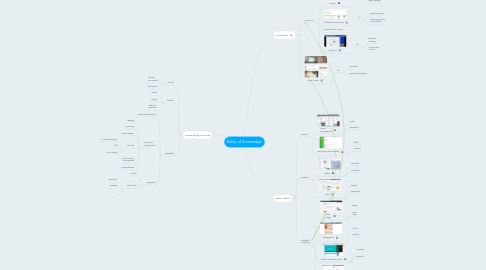
1. Knowledge Sources
1.1. Internal
1.1.1. Shared documents
1.1.2. Wiki spaces
1.2. External
1.2.1. Books
1.2.2. Articles
1.2.3. Internet resources
1.3. Requisites
1.3.1. Folder management
1.3.2. Document management
1.3.2.1. Tagging
1.3.2.2. Versioning
1.3.2.3. Search engine
1.3.2.4. Formats
1.3.2.4.1. Link to web pages
1.3.2.4.2. pdf
1.3.2.4.3. doc, xls,ppt
1.3.2.5. Concurrency management
1.3.2.6. Access policies
1.3.3. Integration
1.3.3.1. Moodle
1.3.3.2. other tools
1.3.3.2.1. Evernote
1.3.3.2.2. Dropbox
1.3.3.2.3. ...
2. Front End
2.1. Social LMS
2.1.1. MOOC
2.1.1.1. for
2.1.1.1.1. generic audience
2.1.1.1.2. basic training
2.1.2. Collaborative learning
2.1.2.1. for
2.1.2.1.1. specific projects
2.1.2.1.2. learning/practice communities
2.1.3. Formal online courses
2.1.4. Webinars
2.1.4.1. for
2.1.4.1.1. blended learning
2.1.4.1.2. Introductory courses
2.2. Social Media
2.2.1. for
2.2.1.1. Promotion
2.2.1.2. Persistence/Updates
3. Back Office
3.1. Shared
3.1.1. Project management
3.1.1.1. Trello
3.1.1.2. Basecamp
3.1.2. Work group social media
3.1.2.1. Slack
3.1.2.2. Yammer
3.2. Personal
3.2.1. Notes
3.2.1.1. Evernote
3.2.1.2. OneNote
3.2.2. Links
3.2.2.1. Pocket
3.2.2.2. Instapaper
3.3. Editing & Publishing
3.3.1. Web pages
3.3.1.1. Sway
3.3.1.2. Spark Page
3.3.2. Infographics
3.3.2.1. Canva
3.3.2.2. Easel.ly
3.3.3. Video & Interactive video
3.3.3.1. YouTube
3.3.3.2. Racontr
3.3.4. Advanced presentations
3.3.4.1. Prezi
3.3.4.2. Spark Video
